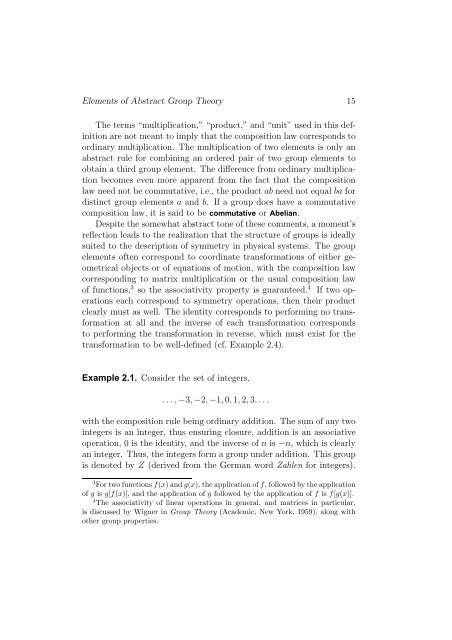Chapter 2 Elements of Abstract Group Theory
Chapter 2 Elements of Abstract Group Theory
Chapter 2 Elements of Abstract Group Theory
You also want an ePaper? Increase the reach of your titles
YUMPU automatically turns print PDFs into web optimized ePapers that Google loves.
<strong>Elements</strong> <strong>of</strong> <strong>Abstract</strong> <strong>Group</strong> <strong>Theory</strong> 15<br />
The terms “multiplication,” “product,” and “unit” used in this definition<br />
are not meant to imply that the composition law corresponds to<br />
ordinary multiplication. The multiplication <strong>of</strong> two elements is only an<br />
abstract rule for combining an ordered pair <strong>of</strong> two group elements to<br />
obtain a third group element. The difference from ordinary multiplication<br />
becomes even more apparent from the fact that the composition<br />
law need not be commutative, i.e., the product ab need not equal ba for<br />
distinct group elements a and b. If a group does have a commutative<br />
composition law, it is said to be commutative or Abelian.<br />
Despite the somewhat abstract tone <strong>of</strong> these comments, a moment’s<br />
reflection leads to the realization that the structure <strong>of</strong> groups is ideally<br />
suited to the description <strong>of</strong> symmetry in physical systems. The group<br />
elements <strong>of</strong>ten correspond to coordinate transformations <strong>of</strong> either geometrical<br />
objects or <strong>of</strong> equations <strong>of</strong> motion, with the composition law<br />
corresponding to matrix multiplication or the usual composition law<br />
<strong>of</strong> functions, 3 so the associativity property is guaranteed. 4 If two operations<br />
each correspond to symmetry operations, then their product<br />
clearly must as well. The identity corresponds to performing no transformation<br />
at all and the inverse <strong>of</strong> each transformation corresponds<br />
to performing the transformation in reverse, which must exist for the<br />
transformation to be well-defined (cf. Example 2.4).<br />
Example 2.1. Consider the set <strong>of</strong> integers,<br />
...,−3, −2, −1, 0, 1, 2, 3,...<br />
with the composition rule being ordinary addition. The sum <strong>of</strong> any two<br />
integers is an integer, thus ensuring closure, addition is an associative<br />
operation, 0 is the identity, and the inverse <strong>of</strong> n is −n, which is clearly<br />
an integer. Thus, the integers form a group under addition. This group<br />
is denoted by Z (derived from the German word Zahlen for integers).<br />
3 For two functions f(x) and g(x), the application <strong>of</strong> f, followed by the application<br />
<strong>of</strong> g is g[f(x)], and the application <strong>of</strong> g followed by the application <strong>of</strong> f is f[g(x)].<br />
4 The associativity <strong>of</strong> linear operations in general, and matrices in particular,<br />
is discussed by Wigner in <strong>Group</strong> <strong>Theory</strong> (Academic, New York, 1959), along with<br />
other group properties.













